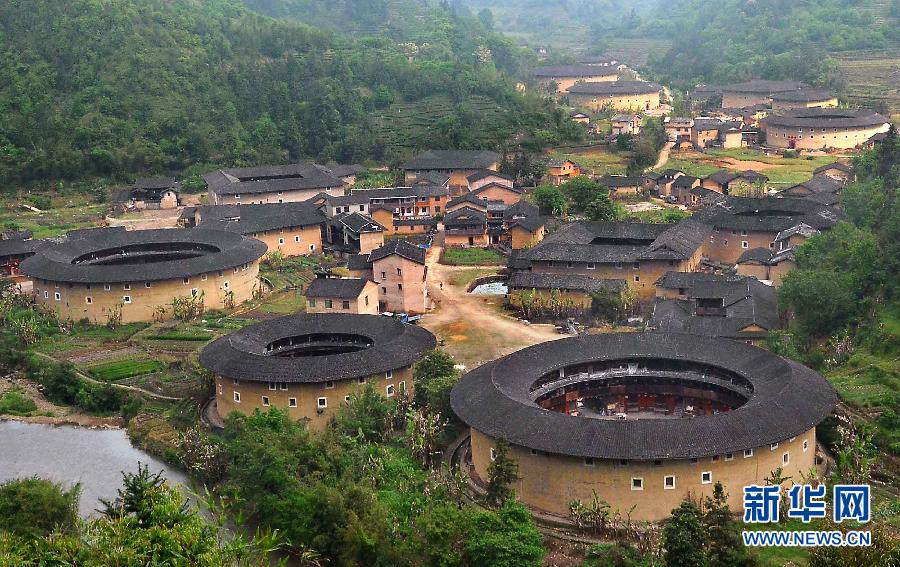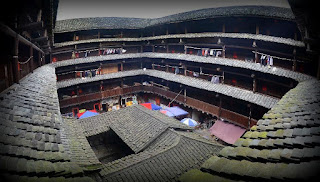 Just because of this image on the left I saw from internet a few months ago, I decided to visit this place-Fujian HakkaTulou. ( I am still wondering where to get the angle to take such an amazing picture, though I have taken a lot of photos during my 2 days trip. )
Just because of this image on the left I saw from internet a few months ago, I decided to visit this place-Fujian HakkaTulou. ( I am still wondering where to get the angle to take such an amazing picture, though I have taken a lot of photos during my 2 days trip. ) UNESCO'S World Heritage Committee added Hakka Tulou earthen houses to its heritage list in July 2008. Since then Fujian Tulou has received plenty of visits, I paid mine in Aug 2012.
The name Tulou is actually made of 2 Chinese words – tu (土) lou (樓). Tu means earthen in this context, while lou means building. The Hakka dwellings are known as Tulou 土楼, literally meaning “mud buildings”. The border where the three provinces of Guangdong, Fujian and Jiangxi meet is littered with tulou’s. I have been to many places in China in the past 20 years, Fujian Tulou, I will list it as an amazing, unique place of China, a place you shouldn't miss it...I am glad to have a chance to visit one of the villages where those unique old buildings nestled in gorgeous tea and rice terraces in the mountainous, and the new concrete town houses and commercial buildings are just all over built nearby the old houses which most of them have more than 1000 years old history.
Unlike other popular tourist area, the tulou in Fujian are not easy to get to from any larger city in China. Fujian Tulou buildings are mainly distributed in Longyan Yongding, Zhangzhou Nanjing and Hua An. The nearest big city is Xiamen, it is about 3 hours driving from airport to Zhangzhou Nanjing Tulou, It is better to hire a car or follow a local tour to the places, as all the Tulou buildings are quite spread out in a few different villages in Zhnagzhou.
 My first stop is Zhangzhou Nanjing, Yunshuiyao, a very quiet and nice small village to relax during the weekend. One of my friends offer us a one nite stay at the hotel Painting Base in Yun Shui Trackway (漳州云水古道写生基地), it is very near to the Tulou area. We were stopped to buy the tickets at the tourist reception center in Shuyang village. All the prices for the tulou are posted in English & Chinese. Most tickets provide entry into 2-4 different tulou or village areas at 90RMB. Along the way there are a few of gate checks to see if tourists are carrying tickets, but yet there are still plenty of locals waiting along the road to offer their transportation, home-stay services and cheaper entry tickets, not sure how does it work. However we follow the rules :) Across the old stone bridges in the left picture is the hotel where we stayed, well, Nanjing (南靖) is a beautiful place, I will post more photos just of it in the next few days.
My first stop is Zhangzhou Nanjing, Yunshuiyao, a very quiet and nice small village to relax during the weekend. One of my friends offer us a one nite stay at the hotel Painting Base in Yun Shui Trackway (漳州云水古道写生基地), it is very near to the Tulou area. We were stopped to buy the tickets at the tourist reception center in Shuyang village. All the prices for the tulou are posted in English & Chinese. Most tickets provide entry into 2-4 different tulou or village areas at 90RMB. Along the way there are a few of gate checks to see if tourists are carrying tickets, but yet there are still plenty of locals waiting along the road to offer their transportation, home-stay services and cheaper entry tickets, not sure how does it work. However we follow the rules :) Across the old stone bridges in the left picture is the hotel where we stayed, well, Nanjing (南靖) is a beautiful place, I will post more photos just of it in the next few days.
...and this is the first Tulou I spotted on the way to hotel, at Zhangzhou Nanjing Yunshui Yao. Even after the tulou received world heritage status and attracted countless visitors, there are still people living within, generation after generation, with a close bonding.
 A tulou is usually a large, enclosed building, most rectangular or circular with very thick load-bearing rammed earth walls between three and five stories high and housing up to 80 families. The ground level is for livestock and kitchen; grains and other food stuff are stored on the second level while the higher floors are for living, a common courtyard at the center. The walls are constructed of local materials- mainly mud with straw, reinforced by bamboo strips. The floors are constructed from thick wood panels. The building is designed to be a well-lit, well-ventilated, windproof and earthquake-proof building that is warm in winter and cool in summer.
A tulou is usually a large, enclosed building, most rectangular or circular with very thick load-bearing rammed earth walls between three and five stories high and housing up to 80 families. The ground level is for livestock and kitchen; grains and other food stuff are stored on the second level while the higher floors are for living, a common courtyard at the center. The walls are constructed of local materials- mainly mud with straw, reinforced by bamboo strips. The floors are constructed from thick wood panels. The building is designed to be a well-lit, well-ventilated, windproof and earthquake-proof building that is warm in winter and cool in summer. 
...the village, the police station and the newly built houses


I visited a few different Tulou buildings during the two days trip, they look about the same, a traditional communal residence of the Hakka community. Huaiyuan Lou is one of them, it is probably the finest tulou here.

Huaiyuanlou includes a ring building and a central hall, it was built in 1909 with four storeys, 136 rooms, residences of generations still occupy the old building today.
Imagine sharing a house with grandparents, parents, siblings and every one of your snotty cousins, sisters-in-laws, brothers-in-laws, and so on, days by days, 80 families not 8 families!!
I think only Children will be happy, Children are always happy...
...the old uncle was listening to radio and singing a hokian song, I saw a few of locals busy doing in the kitchen, treat our tourist in and out at their house are Transparent.
All of the cooking facilities are located in the public courtyard, to minimize the risk of fire in the wood-and-earth structures.
I just cant image how they are leading their life in such an enclosed place, there is no provicy at all.
...another Tulou building not far from Huaiyuan lou
Retangular Tulou ( Ancient apartments)
...
to be continued











1 comment:
Wow, you captured great images. Thank you for the background information.
Post a Comment